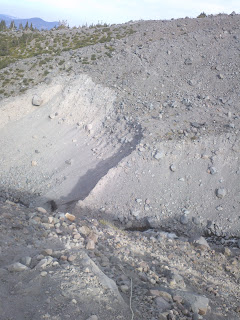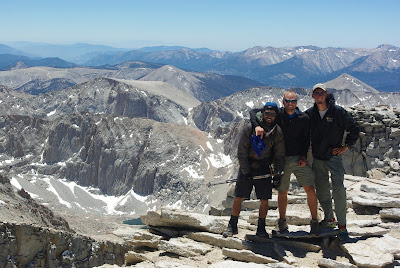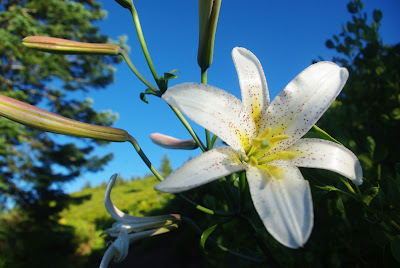As I sit here in my parent's comfortable air-conditioned house, I find it difficult to completely rehabituate into civilization and American society. The past 4.5 months have been an amazing and unique experience that I deeply enjoyed. It compared to no previous adventure of mine; partially because it combined the art of travel with demanding physical activity, but also because I was exposed to the elements 100% of the time. Living with nature and its changing landscapes was liberating. Meeting like minded outdoor enthusiasts was also a perk. The experience liberated me from past restrains keeping me from pursuing and acting on my instincts.
Pictures: Me at the Mexican/US border, look at that noob! Me at the US/Canadian border with my victory cigar!
The PCT provided an opportunity for me to live freely and simply: I wore one set of clothing over the entire trail. I ate cheaply. I spent long periods of time between showers (because they were unnecessary) sometimes going 10-15 day stretches without properly 'cleaning' myself. I haven't shaved my face for almost 5 months, letting it grow into its natural AmeriEuroPino complexion that it is now. I slept under the stars every night, sharing the desert or forest floor with the other living creatures. I lived by the sun, waking up to its rise and falling asleep when it set (for the most part). My goal was Canada, and my days consisted of only one simple exercise; hiking.
Hiking from Mexico to Canada provided me the opportunity to experience the land in context of the human body and it's limitations. Sometimes I felt like I was in sync and in harmony with the surrounding landscape, sometimes I felt disattached. Sometimes I felt like I didn't belong to the particular landscape, or there was no purpose for me being there. However, most times I felt like I was more adept to be living in 'wilderness' compared to living in the city. Regardless if there was any meaning or purpose of hiking the trail and living with nature, I thoroughly enjoyed the experience and am forever grateful of what the experience had provided to me. That's the least I can say about that.
When hiking through the Glacier Peak wilderness, I contemplated a ridiculous questions that thru-hikers are asked quite frequently: Why do you hike?
Though there surely are a variety of ways to answer this question, my response would be: I hike because each changing view proposes a dynamic perspective of distance, time, and aliveness... That, combined with all other external factors (e.g. the elements and the interaction between each element) catapult the human mind into a state of harmony with nature, hence the reason why, in my belief, people enjoy it. There's nothing like climbing a mountain pass from lower elevations: it's vegetation starts thick, grabbing at your legs and waist. The trees block out the sky and you're surrounded by a hodgepodge of busy greenery. Once you reach mid elevations, you can observe the thorny plants and brush starting to thin. By this time, I usually work up quite a sweat, but after passing the tree-line, you're rewarded with the first of many dynamic views. Just when you think your body is fatigued and can't climb any faster, you reach the mountain's saddle combined with what I call an "ahh-se-veynia" moment as a gust of wind greets you with a refreshing sense of accomplishment. "Ahh-se-veynia" because you feel like baby Simba in the Lion King when he's hoisted above the animal kingdom, suspended over a cliff's edge for all to see.
In-parallel with the PCT's nature experience, I met the most amazing people unique to the trail. All had their own stories, backgrounds, and reasons for hiking, but the bond that we created while hiking was pure and real...Where else do 6 different people fart in harmony together, or where else can you camp and socialize with like-minded, nature loving folk for months on end? I'll never forget.
I'll leave you with this:
Buck (PCT 2010) mentioned in his Journal somebody's response after crossing back into the US at the US/Canada border just after finishing her thru-hike. She said "
I heard the burly man in his late-thirties shout at
me-----NEXT!!----- as he waved me over towards him. I gave him my
passport, and then he asked: 'and what was the purpose of your visit to
Canada?' Honestly, I tried hard-----so very hard-----but I couldn't
help but tremble. My eyes watered-up, and I heard myself say: I walked
here. I walked to Canada. I walked to Canada from Mexico on the
Pacific Crest Trail."
It's funny reading this after-the-fact because the exact same thing happened to me just 4 days ago.
Trip Statistics:
Start/End Date: April 27th (Friday of PCTADZKO) through September 13th
Total Days: 140 (4 months 17 days)
Zero Days taken: 11 (Zero days are where 0 PCT miles are hiked, though off trail miles may still be hiked, e.g. finishing the JMT into Yosemite Valley)
Nero Days: A handful (days where about 15 or less PCT miles are hiked)
Miles Hiked: 2,660 trail miles plus about 100 off trail miles
Base Weight: Probably anywhere from 13-15lbs depending (I carried a 3 lb camera)
Maximum Weight Loss: 15lbs (I went from 165lbs to 150 after a few months, then gained some back)
Days of rain: 0
Nights of rain: 1.5
Miles walked on snow: Probably a combined max of 1.5 miles. We got lucky this year!
High Point: 13,200 ft (Forester Pass), though I sumited Mt. Whitney which was 14,505ft
Low Point: Cascade Locks (near sea level, about 240ft)
Start/End: Mexican/US border fence near Campo, CA & Canada/US border near Manning Park, BC
Average miles hiked per day: 25-30 (max day hiked was 36mi)
Number of Thru-Hike Attempts at start: about 700, but this number is questionable based on the number of people who attended the PCTADZKO, registered for thru-hiking permits, etc.
Number of successful thru hikes: Not sure, I'm guessing 200+ people will successfully complete a thru-hike this year
Hiking Partners: 3-Bears (Desert 700 miles), Ant Eater (Kennedy Meadows to Canada, about 2000+miles), Pilfer (Belden to Canada, about 1300 miles). Honorable mentions: Ben Tucker, Beef Nugget and Smiles, The Three Caballeros, Houdini, Gully, Robin Hood and Tortuga, El Capitan and Cool Ranch and the rest of Team Fuck-It, Fig, Nancy, Scott, Calf and Ruby Locks, Data, Scrambled Legs, Good Times, Scarecrow, Sanjay, and many, many more!
Mexican/US Border
Typical So-Cal Trail Blaze
Headed towards Warner Springs and perched on this rock
On our way to Big Bear w/ 3bears and Pop Star
Sleepy hiker trash
Greeted with this inspiring sign before the High Sierra
Atop Mt. Whitney in the Sierra Nevada range
Diving into an alpine lake at Muir Pass around 11,000ft
Hike naked day: June 21st
Ant-Eater and Dirty Brown kickin' outside Tuolomne Meadows
One of my favorite camping spots just before Senora Pass (northern part of the high Sierra)
Sunset at Senora Pass
PCT midway point
Sleepy hiker after a big day crossing Hat Creek Rim (huge waterless stretch)
Getting spoiled by trail angels at Honker Pass (don't mind the creepy beard)
Wild Lilly
Hitching into Shasta... didn't work to well this time
Last stop in California, or should I say the State of Jefferson!
Rimmin' at Crater Lake
Beautiful Crater Lake
Oregon: most of it burned
Goat Rocks Wilderness is EPIC
Data and Pilf, Olympia vs Schmidt..
Awww moment in the Glacier Peak Wilderness
Sanjay thinking he's a penguin at Mica Lake in GPW
The only sketchy part of the entire PCT was this river crossing
Bus ride into Stehekin was quite entertaining
Beautiful and scenic North Cascades
My last journal entry
Look mom, I made it to Canada!




























































